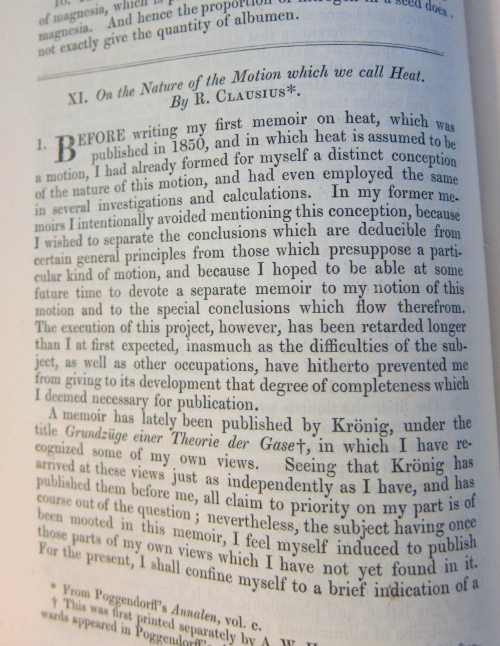JF Ptak Science Books
Clausius, Rudolf. "On the Nature of the Motion we call Heat". London And Edinburgh Philosophical Magazine And Journal of Science, volume 14, fourth series, 1857, printed by Richard and John Taylor, and edited by David Brewster, Richard Taylor, Richard Phillips, Robert Kane. 21x13cm, vii, 560pp. Pp 108-127.
The is the first appearance in English of Clausius' major paper in kinetic theory, “Ueber die Art der Bewegung, welche wir Warmenennen,” Annalen der Physik, 100 (1857), 497–507, which was foundational in the areas of kinetic theory and statistical mechanics.
Bound in half calf and marbled boards; front board detached, half of spine covering missing, some foxing to plates; the text is fresh and crisp, and the binding tight. Good copy. $950
Other papers in this volume include Plateau "Experimental and Theoretical Research on the Figures of Equilibrium of a Liquid..." parts II and III of a three-part paper; the great W.S. Jevons "On the Cirrous Form of Cloud" and "On a Sun Gauge"; Draper "On the Measurement of the Chemical Action of Light"; Joule "On Heat and the Constitution of Elastic Fluids"; Huxley "On the Structure of Glacial Ice"; Waterston "On the Deviation from the Primary Laws of Elastic Fluids...", and numerous others.
The Dictionary of Scientific Biography discusses the 1857 paper beginning with the appraisal of JC Maxwell (in reference to his Theory of Heat):
"Maxwell...hailed Clausius as the founder of a new science. Clausius’ first venture into the kinetic theory was “Ueber die Art der Bewegung, welche wir Warmenennen and his image of molecular motion went far beyond the “billiard ball” model of such previous writers as Kronig. He ascribed rotatory and vibratory, as well as translational, motion to the molecules, a complexity that led to an important conclusion. The conservation of translational kinetic energy in collision could no longer be assumed, because collisions might cause transformations of one form of motion into another. Quite obviously, Clausius argued, the idea of a constant equal velocity for all molecules must be untenable. By supposing that translational velocities would vary among the molecules, Clausius offered an explanation for the evaporation of a liquid. Since only molecules with higher than average velocities possess sufficient kinetic energy to escape the attractive forces of the liquid temperature...In his discussion of the complexity of molecular motions, Clausius did not merely suggest that motions other than translational were a possibility; he demonstrated that such motions must exist by showing that translational motion alone could not account for all of the heat present in a gas..."
"This 1857 paper also marked another important beginning in physical theory, for it presented the first physical argument in support of Avogadro’s hypothesis that equal volumes of gases at the same temperature and pressure contain equal numbers of molecules. Clausius argued that if it were assumed that all types of molecules possess the same translational energy at equal temperatures, then, since all gases have the same relationship between pressure, volume, and temperature and pressure, volume and temperature, they would necessarily contain equal numbers of molecules in equal volumes at the same temperature and pressure. Avogadro’s hypothesis, therefore, found support in the mechanical theory of heat, independently of the usual chemical arguments."--DSB, volume 3, pp306-7





Comments